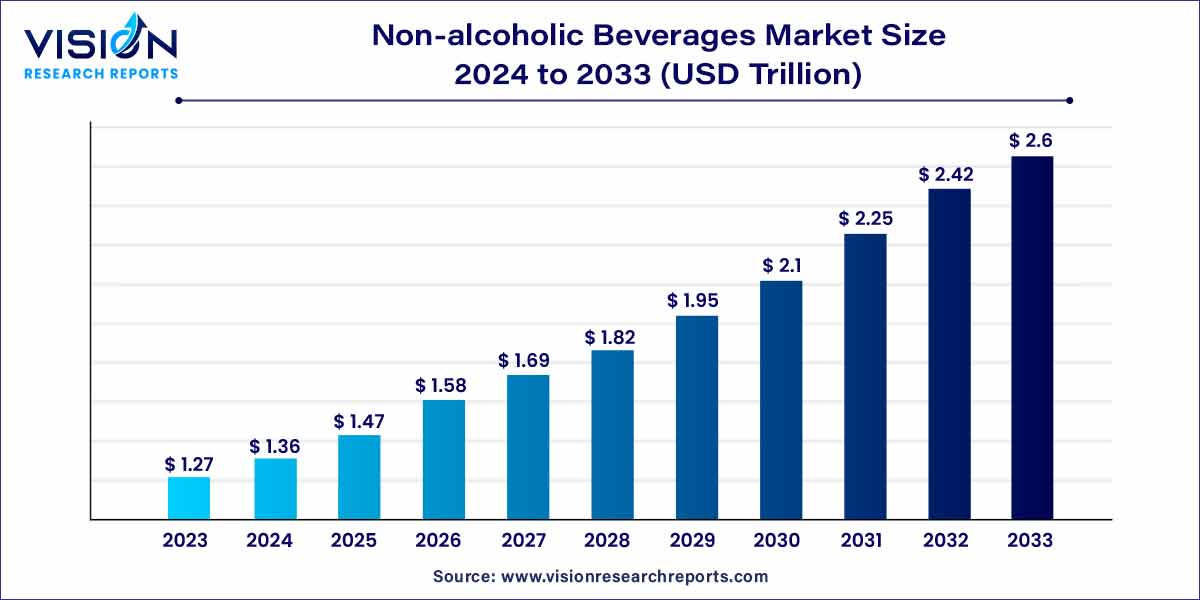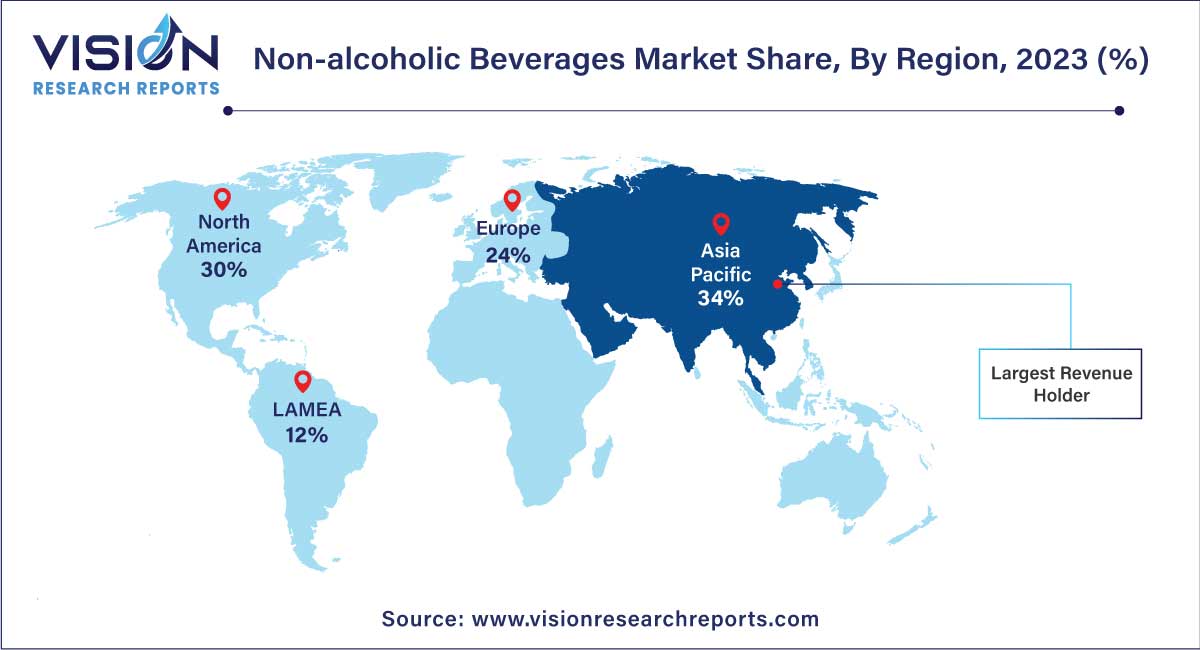The global non-alcoholic beverages market size was estimated at around USD 1.27 trillion in 2023 and it is projected to hit around USD 2.6 trillion by 2033, growing at a CAGR of 7.44% from 2024 to 2033. The non-alcoholic beverages market is driven by the rising demand for non-alcoholic beer and wine, increasing awareness of health risks, and innovation in product offerings.

The non-alcoholic beverages market has witnessed significant growth and evolution in recent years, driven by changing consumer preferences, health-conscious trends, and innovative product offerings. This overview delves into key aspects of the non-alcoholic beverages market, highlighting its current landscape and future prospects.
The non-alcoholic beverages market is experiencing robust growth, driven by several key factors. A fundamental driver is the shifting consumer preferences towards healthier lifestyle choices. As awareness of the health risks associated with excessive alcohol consumption increases, there is a corresponding surge in demand for non-alcoholic alternatives. Moreover, the industry's commitment to innovation plays a pivotal role in this growth, with manufacturers introducing a diverse range of products that cater to evolving consumer tastes. From functional beverages to unique flavor profiles, the continuous exploration of novel offerings contributes significantly to market expansion. The rise of health and wellness trends is another influential factor, propelling the demand for beverages that offer nutritional benefits. As consumers seek alternatives that align with their well-being goals, the non-alcoholic beverages market is well-positioned for sustained growth in the foreseeable future.
| Report Coverage | Details |
| Market Revenue by 2033 | USD 2.6 trillion |
| Growth Rate from 2024 to 2033 | CAGR of 7.44% |
| Revenue Share of Asia Pacific in 2023 | 34% |
| Base Year | 2023 |
| Forecast Period | 2024 to 2033 |
| Market Analysis (Terms Used) | Value (US$ Million/Billion) or (Volume/Units) |
In 2023, the carbonated soft drinks (CSDs) segment claimed the largest revenue share at 29%. Renowned for their effervescence and an extensive range of flavors catering to diverse taste preferences, CSDs have gained popularity. Their convenience and availability in various packaging sizes make them a preferred choice for consumers seeking a quick and satisfying thirst-quencher.
The functional beverages segment is predicted to grow at the remarkable CAGR in the forecast period. This surge is attributed to the increasing awareness and emphasis on health and wellness. As consumers become more health-conscious, there is a rising demand for beverages that provide not only refreshment but also functional benefits. Functional beverages, encompassing products enriched with vitamins, minerals, antioxidants, and other health-promoting ingredients, align with the contemporary focus on preventive healthcare and overall well-being
In 2023, the retail segment held the largest revenue share of 73% and is expected to continue expanding at the fastest CAGR throughout the forecast period. The retail channel encompasses supermarkets, hypermarkets, internet retailers, and other outlets. Among these, supermarkets and hypermarkets within this segment hold the largest market share due to the availability of a wide variety of brands and products under one roof. Notable players in this subcategory include Whole Foods, Target, Aldi, and Walmart, with several supermarkets expanding their offerings in the alcohol-free market.
The foodservice segment is anticipated to experience rapid growth in the forecast period, serving as a primary distribution channel for non-alcoholic beverages. The global trend of busy schedules and increased disposable income often prompts consumers to dine out. This has led to the emergence of new eateries catering to diverse tastes and beverage preferences. The growth in full-service restaurants adopting all-inclusive dining practices, wherein they analyze local dietary trends and innovate their offerings accordingly, has been a significant driver. This approach not only enhances the consumer experience but also increases the frequency of visits to these establishments.
In 2023, Asia Pacific region dominated the market with the largest market share of 34%. The region, fueled by increasing demand for alcohol-free beverages in developing countries such as China, India, Thailand, and Malaysia, is anticipated to drive market growth. Government initiatives aimed at boosting the manufacturing sector through tax cuts, subsidies, and elevated Foreign Direct Investment (FDI) limits have attracted key global players to expand their operations and distribution facilities in the region. Shifting beverage consumption patterns, with consumers preferring functional and flavored bottled water over high-sugar content carbonated drinks, further contribute to this trend.

China, as the leader in the Asia Pacific market in 2023, played a pivotal role, accounting for the largest share. The surge in health consciousness among Chinese consumers, driven by increased awareness of the health impacts of lifestyle choices, has led many to opt for non-alcoholic beverages as a healthier alternative to traditional sugary and alcoholic drinks. This trend is particularly prominent among the younger generation, actively seeking beverages that align with their desire for a balanced and nutritious diet.
North America is poised for significant growth during the forecast period. The U.S., home to many globally renowned beverage manufacturers, faces challenges such as the rising prevalence of obesity and government-imposed taxes on sugar products in both the U.S. and Mexico. These factors restrain the demand for Carbonated Soft Drinks (CSDs), a subset of non-alcoholic beverages, leading to an increased preference for low-calorie beverages containing non-nutritive sweeteners.
By Product
By Distribution channel
By Region
Chapter 1. Introduction
1.1. Research Objective
1.2. Scope of the Study
1.3. Definition
Chapter 2. Research Methodology
2.1. Research Approach
2.2. Data Sources
2.3. Assumptions & Limitations
Chapter 3. Executive Summary
3.1. Market Snapshot
Chapter 4. Market Variables and Scope
4.1. Introduction
4.2. Market Classification and Scope
4.3. Industry Value Chain Analysis
4.3.1. Raw Material Procurement Analysis
4.3.2. Sales and Distribution Channel Analysis
4.3.3. Downstream Buyer Analysis
Chapter 5. COVID 19 Impact on Non-alcoholic Beverages Market
5.1. COVID-19 Landscape: Non-alcoholic Beverages Industry Impact
5.2. COVID 19 - Impact Assessment for the Industry
5.3. COVID 19 Impact: Global Major Government Policy
5.4. Market Trends and Opportunities in the COVID-19 Landscape
Chapter 6. Market Dynamics Analysis and Trends
6.1. Market Dynamics
6.1.1. Market Drivers
6.1.2. Market Restraints
6.1.3. Market Opportunities
6.2. Porter’s Five Forces Analysis
6.2.1. Bargaining power of suppliers
6.2.2. Bargaining power of buyers
6.2.3. Threat of substitute
6.2.4. Threat of new entrants
6.2.5. Degree of competition
Chapter 7. Competitive Landscape
7.1.1. Company Market Share/Positioning Analysis
7.1.2. Key Strategies Adopted by Players
7.1.3. Vendor Landscape
7.1.3.1. List of Suppliers
7.1.3.2. List of Buyers
Chapter 8. Global Non-alcoholic Beverages Market, By Product
8.1. Non-alcoholic Beverages Market, by Product, 2024-2033
8.1.1. Carbonated Soft Drinks
8.1.1.1. Market Revenue and Forecast (2021-2033)
8.1.2. Bottled Water
8.1.2.1. Market Revenue and Forecast (2021-2033)
8.1.3. RTD Tea & Coffee
8.1.3.1. Market Revenue and Forecast (2021-2033)
8.1.4. Functional Beverages
8.1.4.1. Market Revenue and Forecast (2021-2033)
8.1.5. Juices
8.1.5.1. Market Revenue and Forecast (2021-2033)
8.1.6. Dairy-based Beverages
8.1.6.1. Market Revenue and Forecast (2021-2033)
8.1.7. Others
8.1.7.1. Market Revenue and Forecast (2021-2033)
Chapter 9. Global Non-alcoholic Beverages Market, By Distribution channel
9.1. Non-alcoholic Beverages Market, by Distribution channel, 2024-2033
9.1.1. Food Service
9.1.1.1. Market Revenue and Forecast (2021-2033)
9.1.2. Retail
9.1.2.1. Market Revenue and Forecast (2021-2033)
Chapter 10. Global Non-alcoholic Beverages Market, Regional Estimates and Trend Forecast
10.1. North America
10.1.1. Market Revenue and Forecast, by Product (2021-2033)
10.1.2. Market Revenue and Forecast, by Distribution channel (2021-2033)
10.1.3. U.S.
10.1.3.1. Market Revenue and Forecast, by Product (2021-2033)
10.1.3.2. Market Revenue and Forecast, by Distribution channel (2021-2033)
10.1.4. Rest of North America
10.1.4.1. Market Revenue and Forecast, by Product (2021-2033)
10.1.4.2. Market Revenue and Forecast, by Distribution channel (2021-2033)
10.2. Europe
10.2.1. Market Revenue and Forecast, by Product (2021-2033)
10.2.2. Market Revenue and Forecast, by Distribution channel (2021-2033)
10.2.3. UK
10.2.3.1. Market Revenue and Forecast, by Product (2021-2033)
10.2.3.2. Market Revenue and Forecast, by Distribution channel (2021-2033)
10.2.4. Germany
10.2.4.1. Market Revenue and Forecast, by Product (2021-2033)
10.2.4.2. Market Revenue and Forecast, by Distribution channel (2021-2033)
10.2.5. France
10.2.5.1. Market Revenue and Forecast, by Product (2021-2033)
10.2.5.2. Market Revenue and Forecast, by Distribution channel (2021-2033)
10.2.6. Rest of Europe
10.2.6.1. Market Revenue and Forecast, by Product (2021-2033)
10.2.6.2. Market Revenue and Forecast, by Distribution channel (2021-2033)
10.3. APAC
10.3.1. Market Revenue and Forecast, by Product (2021-2033)
10.3.2. Market Revenue and Forecast, by Distribution channel (2021-2033)
10.3.3. India
10.3.3.1. Market Revenue and Forecast, by Product (2021-2033)
10.3.3.2. Market Revenue and Forecast, by Distribution channel (2021-2033)
10.3.4. China
10.3.4.1. Market Revenue and Forecast, by Product (2021-2033)
10.3.4.2. Market Revenue and Forecast, by Distribution channel (2021-2033)
10.3.5. Japan
10.3.5.1. Market Revenue and Forecast, by Product (2021-2033)
10.3.5.2. Market Revenue and Forecast, by Distribution channel (2021-2033)
10.3.6. Rest of APAC
10.3.6.1. Market Revenue and Forecast, by Product (2021-2033)
10.3.6.2. Market Revenue and Forecast, by Distribution channel (2021-2033)
10.4. MEA
10.4.1. Market Revenue and Forecast, by Product (2021-2033)
10.4.2. Market Revenue and Forecast, by Distribution channel (2021-2033)
10.4.3. GCC
10.4.3.1. Market Revenue and Forecast, by Product (2021-2033)
10.4.3.2. Market Revenue and Forecast, by Distribution channel (2021-2033)
10.4.4. North Africa
10.4.4.1. Market Revenue and Forecast, by Product (2021-2033)
10.4.4.2. Market Revenue and Forecast, by Distribution channel (2021-2033)
10.4.5. South Africa
10.4.5.1. Market Revenue and Forecast, by Product (2021-2033)
10.4.5.2. Market Revenue and Forecast, by Distribution channel (2021-2033)
10.4.6. Rest of MEA
10.4.6.1. Market Revenue and Forecast, by Product (2021-2033)
10.4.6.2. Market Revenue and Forecast, by Distribution channel (2021-2033)
10.5. Latin America
10.5.1. Market Revenue and Forecast, by Product (2021-2033)
10.5.2. Market Revenue and Forecast, by Distribution channel (2021-2033)
10.5.3. Brazil
10.5.3.1. Market Revenue and Forecast, by Product (2021-2033)
10.5.3.2. Market Revenue and Forecast, by Distribution channel (2021-2033)
10.5.4. Rest of LATAM
10.5.4.1. Market Revenue and Forecast, by Product (2021-2033)
10.5.4.2. Market Revenue and Forecast, by Distribution channel (2021-2033)
Chapter 11. Company Profiles
11.1. Nestlé
11.1.1. Company Overview
11.1.2. Product Offerings
11.1.3. Financial Performance
11.1.4. Recent Initiatives
11.2. PepsiCo
11.2.1. Company Overview
11.2.2. Product Offerings
11.2.3. Financial Performance
11.2.4. Recent Initiatives
11.3. Keurig Dr. Pepper Inc.
11.3.1. Company Overview
11.3.2. Product Offerings
11.3.3. Financial Performance
11.3.4. Recent Initiatives
11.4. The Coca-Cola Company
11.4.1. Company Overview
11.4.2. Product Offerings
11.4.3. Financial Performance
11.4.4. LTE Scientific
11.5. Jones Soda Co.
11.5.1. Company Overview
11.5.2. Product Offerings
11.5.3. Financial Performance
11.5.4. Recent Initiatives
11.6. Danone S.A
11.6.1. Company Overview
11.6.2. Product Offerings
11.6.3. Financial Performance
11.6.4. Recent Initiatives
11.7. Suntory Beverage & Food Ltd
11.7.1. Company Overview
11.7.2. Product Offerings
11.7.3. Financial Performance
11.7.4. Recent Initiatives
11.8. Asahi Group Holdings, Ltd.
11.8.1. Company Overview
11.8.2. Product Offerings
11.8.3. Financial Performance
11.8.4. Recent Initiatives
11.9. Red Bull
11.9.1. Company Overview
11.9.2. Product Offerings
11.9.3. Financial Performance
11.9.4. Recent Initiatives
Chapter 12. Research Methodology
12.1. Primary Research
12.2. Secondary Research
12.3. Assumptions
Chapter 13. Appendix
13.1. About Us
13.2. Glossary of Terms
 Cross-segment Market Size and Analysis for
Mentioned Segments
Cross-segment Market Size and Analysis for
Mentioned Segments
 Additional Company Profiles (Upto 5 With No Cost)
Additional Company Profiles (Upto 5 With No Cost)
 Additional Countries (Apart From Mentioned Countries)
Additional Countries (Apart From Mentioned Countries)
 Country/Region-specific Report
Country/Region-specific Report
 Go To Market Strategy
Go To Market Strategy
 Region Specific Market Dynamics
Region Specific Market Dynamics Region Level Market Share
Region Level Market Share Import Export Analysis
Import Export Analysis Production Analysis
Production Analysis Others
Others